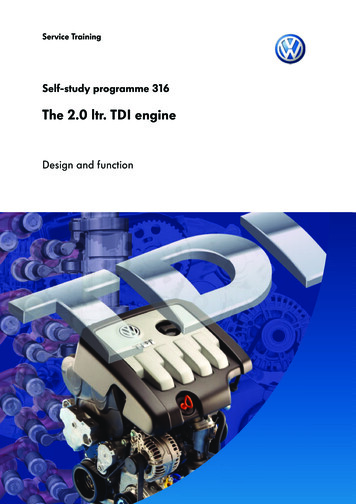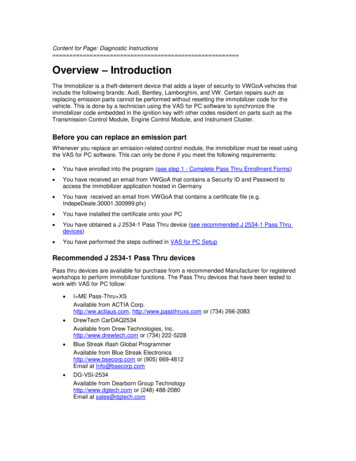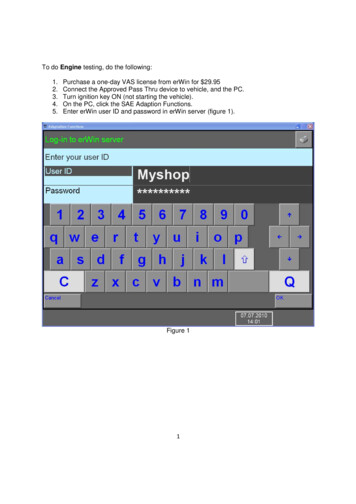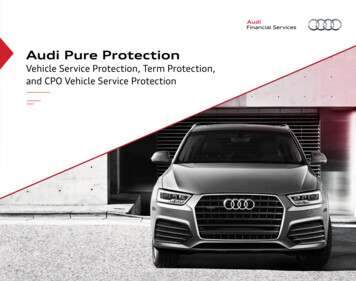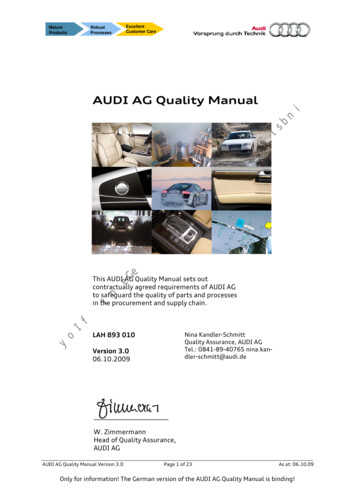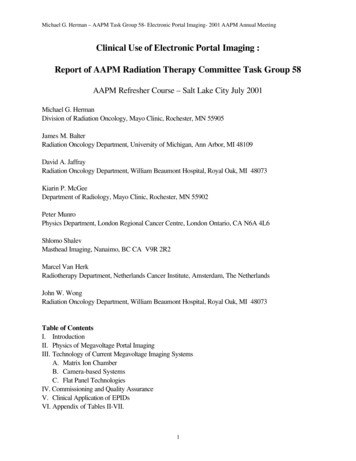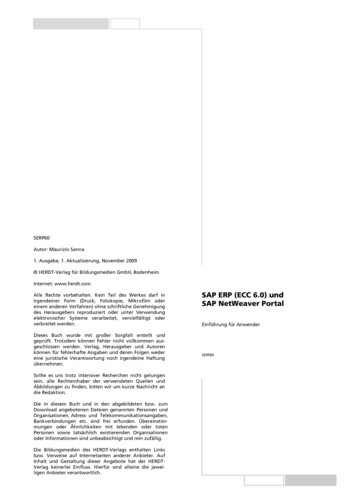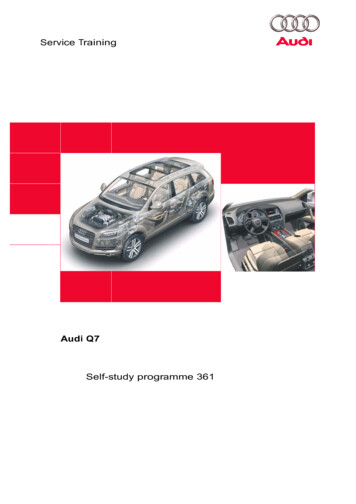
Transcription
Service TrainingAudi Q7Self-study programme 361
The Audi Q7In superior fashion, the Audi Q7 combinessportiness and versatility, advanced technology andpremium-class luxury.On the road, it excels with the driving performanceand dynamics of a sports car, while redefining thepossibilities of its class off-road. A vehicle whichvisually display all its qualities and meets itspromise in technological terms, on any road andunder any conditions.The very design of the Audi Q7 sets new standards.Characteristic of the typical Audi dynamism are theswooping curve of the roofline and the distinctiverelationship between the high waistline and narrowwindow area. The dynamic sweep of the front sectionand the powerful rear with the sharply sloping Dpillars provide a coupe-like profile.Equally characteristic elements of the current Audistyling are the shoulder line and dynamic line whichdefine the side section.Audi Q7 – the high-performance SUV from thecreator of quattro.361 000Taking the lead: With design & performance
ContentsIntroduction . . . . . . . . . . . . . . . . . . . . . . . . . . . . . . . . . . . . . . 4Body . . . . . . . . . . . . . . . . . . . . . . . . . . . . . . . . . . . . . . . . . . . . 8Passenger protection . . . . . . . . . . . . . . . . . . . . . . . . . . . . . 12Engine . . . . . . . . . . . . . . . . . . . . . . . . . . . . . . . . . . . . . . . . . . 34Running gear. . . . . . . . . . . . . . . . . . . . . . . . . . . . . . . . . . . . 44Electrical system . . . . . . . . . . . . . . . . . . . . . . . . . . . . . . . . . 50Air conditioning system . . . . . . . . . . . . . . . . . . . . . . . . . . 54Infotainment . . . . . . . . . . . . . . . . . . . . . . . . . . . . . . . . . . . . 68The self-study programme provides basic information on the design and function of new vehicle models,new vehicle components or new technologies.The self-study programme is not intended as a workshop manual.The specified values only serve for better understanding and relate to the software versionsapplicable at the time the SSP was compiled.For maintenance and repair operations it is essential that you refer to the current technical literature.NoteNote
IntroductionIn a nutshellSome Audi Q7 dimensions.361 045361 0465-seater4.2l FSI3.0l TDI2895295030653120Unladen weight without driver in kg4.2l FSI3.0l TDI2240229522702325Drag coefficient Cw0.37Tank capacity in litres100350032001401306495655063656420Trailer weight, braked (on 12 % uphillgradient) in kgNose weight in kg46/7-seaterAdmissible total weight in kgCombination weight (12 %) in kg4.2l FSI3.0l TDIAdmissible roof load in kg100
Interior dimensions361 103Luggage compartment volume775 l330 l361 105361 1042035 l361 1065
IntroductionBodyThe body of the Audi Q7 has been newly developed by Audi and is not based on a predecessor SUV model.During the development process, the most significant properties and characteristic values were initiallydefined. For example: body weight torsional and bending values crash performance scheduled development time scope of simulation and prototype development planned insurance categorySignificant features of the Audi Q7 body shell are a high overall rigidity as well as optimised local bending andtorsional values at the body nodes and force application areas.Bodyshell361 055The development of an open sky system, an optional third seat row,a tailgate with integrated rear lights, which wrapsaround to the rear side panel,were further important features. The focus was on combining these elements withthe typical Audi high quality expressed, for instance,in the dimensional accuracy of the body parts, thenarrow gap widths and surface finish.6The self-supporting, lightweight steel body of theAudi Q7 is built in four bodyshell versions: Normal roof Normal roof with three seat rows Panorama roof (open sky system) Panorama roof (open sky system) with three seatrowsThe Audi Q7 with three seat rows is equipped withan additional cross-piece in the spare wheel wellarea for attachment of the seat belts. On theversions with the panorama roof, the cross-pieces atthe B and C-pillars are dispensed with. Theirfunction is fulfilled by the open sky module.
Joining techniquesIn order to meet the high demands with regard tobody rigidity, crash safety and optimised productionprocesses, the following joining techniques areemployed on the Audi Q7:–––––Spot weldingSpot weld bondingMAG weldingLaser solderingPlasmatron solderingThe joining technique most frequently employed forareas subject to high loads is spot weld bondingusing a structural adhesive.AdhesivePlasmatron solderingLaser solderingSpot welding (not shown)MAG welding (not shown)The bonded joints, with a length of 79815 mm,comprise 5403 spot welds. The total length of thelaser-soldered joints (seamless joints between roofand side frame) amounts to 4420 mm. As with theAudi A3 Sportback and the Audi A6 Avant '05, theside panel and the rain channel are joined usingplasmatron soldering. Like laser soldering, thistechnique ensures a high-quality and a virtuallyinvisible seam. The length of the left and right jointsamounts to 1438 mm. The length of the MAGwelded joints, used in areas which are inaccessibleusing welding tongs, amounts to 15272 mm.361 0577
BodyMaterialsIn addition to the joining techniques employed,selection of the correct materials is vital forachieving both crash safety and body rigidity.Depending on loading and weight, the mostsuitable material is determined for eachcomponent.The proportions of the individual materials used areas follows:– Standard steels 36 %– High-strength steels 26 %– Higher-strength and super high-strength steels32 %– Aluminium 6%The wing panels, bonnet and tailgate are made ofaluminium, making them some 22 kilogrammeslighter than their steel counterparts. The weight wasfurther reduced through the use of various semifinished products*. With tailored rolled blanks, forexample, the wall thicknesses can be adapted towithstand differing component loading. Thereinforcements for the rear longitudinal membersand the floor cover panel are made from tailoredrolled blanks.* Semi-finished products: Pre-processed materialsfor the manufacture of parts and components8The sill tube consists of a rolled section because themanufacturing tolerances are lower in this casethan for an extruded tube, enabling smaller wallthicknesses. In order to meet pedestrian protectionrequirements, plastic parts are used in the plenumchamber/bulkhead area.
Standard steelsHigh strength steelsHigher-strength and super high-strength steelsAluminium361 0569
BodySeat conceptThe Audi Q7 seats up to seven occupants. As standard, the Audi Q7 is equipped with five seats.The Audi Q7 can optionally be fitted with electrically-adjustable seats for the driver and front passenger.A memory function is also available for the front seats. The backrests of the driver and front passenger seatshave been ergonomically designed such as to reduce to distance between the occupant's head and the headrestraint. The headrest must be adjusted correctly for this purpose. The seats in the second seat row can beindividually adjusted longitudinally and offer occupants the most generous leg room in this vehicle class. Wherethe Audi Q7 is equipped with a third seat row, the second seat row features an easy-entry function andlongitudinal seat adjustment. In the 6-seater equipment version, comfort seats are optionally available for thesecond seat row.Audi Q7 with seven seatsAudi Q7 with six seats361 050Audi Q7 with five seats361 052NotePlease refer to the owner's manual forinformation on operation of thevehicle seats.361 04910
The head restraints of the second seat row do notprevent the backrests from folding. When the headrestraints of the second seat row are lowered, thebackrests do not fully reach the load floor position.When folding down the backrests of the third seatrow, the head restraints lower automatically, makingit easier to fold down the backrests.If the seats in the second and third seat roads areunoccupied, the head restraints can be lowered byhand in order to improve rearward visibility.The easy-entry function on the second seat row isoperated via a lever next to the head restraint. Thebackrest folds forwards to a certain angle. The seatbase also moves in the direction of travel. The easyentry function enables the occupants to enter andexit the third seat row.361 051Attachment of the seat belts to the seats of the thirdseat row is achieved via additional belt buckles. Theadvantage is that the seatbelts can be removedfrom the seats as required. The seat belts areretracted and the latch plates can be inserted in theD-pillar trim. In this manner, the seat belts areprotected against damage during loading of theluggage compartment when the backrests arefolded down. The central belt buckles are attachedto the vehicle floor.Persons above a height of 160 cm are prohibitedfrom being seated in the third seat row.361 04411
Passenger protectionPassenger protection in the Audi Q7Owing to its wide range of use, the Audi Q7 represented a special challenge for the development team:A high degree of passenger protection during both on-road and off-road operation.In meeting these requirements, the Audi Q7 fits seamlessly into the high safety level of the current Audi modelrange.The passenger protection system of the Audi Q7 comprises the following components and systems:–––––––––––Airbag control unitDriver and front passenger airbag, dual stageFront side airbagsSideguards (curtain airbags)Crash sensors for front airbag, the so-called upfront sensors for frontal impact detectionCrash sensors at the B-pillars for side impact detectionCrash sensors at the C-pillars for side impact detectionFront belt tensionersBattery isolation igniterSwitch in front-seat belt bucklesSeat occupied sensor in front passenger seatSide airbags for the second seat row and a key operated switch for deactivation of the front passenger airbagwith the corresponding warning lamp are also available as optional equipment.Owing to the various requirements and statutory regulations placed upon vehicle manufacturers by themarkets, the equipment versions may vary, particularly with regard to the US market.KeyE24 Driver side belt switchE25 Front passenger side belt switchE224 Key operated switch to deactivate frontpassenger side airbagG128 Seat occupied sensor, front passenger sideG179 Side airbag crash sensor on driver side(B-pillar)G180 Side airbag crash sensor on front passengerside (B-pillar)G256 Rear side airbag crash sensor on driver side(C-pillar)G257 Rear side airbag crash sensor on passengerside (C-pillar)12
361 001G283 Front airbag crash sensor for driver side(front end, left)G284 Front airbag crash sensor for front passengerside (front end, right)J234J285J393J533J623Airbag control unitControl unit in dash panel insertConvenience system central control unitData bus diagnostic interface (gateway)Engine control unitK19 Seat belt warning system warning lampK75 Airbag warning lampK145 Front passenger side airbag deactivatedwarning lamp (PASSENGER AIRBAG ver side airbag igniterDriver side airbag igniter 2Front passenger side airbag igniter 1Front passenger side airbag igniter 2Driver seat belt tensioner igniter 1Front passenger seat belt tensioner igniter 1Side airbag igniter on driver sideSide airbag igniter on front passenger sideDriver side curtain airbag igniterFront passenger side curtain airbag igniterBattery isolation igniterT16Connector, 16-pin (diagnostic connection)13
Passenger protectionAirbag control unit J234The purpose of the electronics integrated in the airbag control unit is to detect vehicle deceleration oracceleration and to evaluate it so as to detect a vehicle impact. In order to detect vehicle deceleration oracceleration during an impact, external sensors are used in addition to the sensors installed inside the controlunit. The electronics in the control unit detect a crash based alone on the information received from the sensors.Only once all the sensor information has been evaluated by the control unit electronics can the electronicsdecide when and which safety components should be activated.The airbag control unit is able to detect frontal, side and rear impacts.A further task of the airbag control unit is to activate the relevant restraint systems (belt tensioners or belttensioners and airbag) depending on the type and severity of the impact as well as signalling the crash toother vehicle systems.The airbag electronics have the following maintasks:– Crash detection (front, side, rear)– Defined triggering of the belt tensioners, airbagsand battery isolation igniter– Defined triggering of the second front airbagstage– Evaluation of all input information– Permanent monitoring of the complete airbagsystem– Independent power supply via a capacitor fora defined time (approx. 150 ms)– Fault display via a failure warning lamp– Storage of fault and crash information– Communication of a crash to the other systemcomponents via the drive CAN or discrete crashoutput (conventional wiring)– Activation of seat belt warning system361 007For information on which components must be replaced following an accident, please refer to the applicableWorkshop Manual in ELSA. An airbag control unit can only be replaced with the aid of an online-capable VAS5051 or VAS 5052. The guided fault-finding or guided function applications must be used for this purpose. Theairbag control unit must be coded and adapted to the relevant vehicle. If coding or adaption is not performedcorrectly, this may result in malfunctions in other vehicle systems, e.g. the ESP.14
Data exchangeThe airbag control unit is connected to the drive CAN.The airbag control unit transmits the following information via the drive CAN:– Activation of warning lamp K75– Activation of seat belt warning system– Diagnostic data– Crash signal– Crash information for the control element test– ESP data– Front passenger airbag activated/deactivated status (display in dash panel insert)The airbag control unit evaluates the following information from the data bus:– Dimming for the front passenger side airbag deactivated warning lamp (Passenger Airbag Off)The information that a crash has occurred is used by other control units in order to unlock a locked centrallocking system, cut off the fuel supply, activate the hazard warning lights etc.Airbag warning lamp K75Activation of the airbag warning lamp, which is located in the dash panel insert J285, is performed via theCAN bus. In the absence of a data message from the airbag control unit, the warning lamp is switched onautomatically by the dash panel insert.Rear impact recognitionDuring a rear impact, the vehicle is strongly accelerated in the direction of travel. The crash sensors in theairbag control unit and the crash sensors G283 and G284 detect this vehicle acceleration and transmit therelevant signals to the airbag electronics. The airbag electronics evaluate the information. If the sensorsignals exceed a specified value, the belt tensioners are triggered and the battery isolation igniter is activated.15
Passenger protectionSeat belt warning systemThe Audi Q7, like the Audi A6 05 for example, features a seat belt warning function for the driver and frontpassenger.When the ignition is switched on, the airbag control unit evaluates the information from the driver and frontpassenger belt buckle switches as well as information from the front passenger side seat occupied sensor.The airbag control unit detects whether the front passenger seat is occupied or not based on the resistancevalues of the front passenger side seat occupied sensor. If the driver or front passenger have not fastened theirseat belts, they are alerted via the seat belt warning system warning lamp K19 in the dash panel insert and anaudible signal.Timing diagrams for the seat belt warning systemVisual and audible signals – seat belts are fastened lateTerminal 15Vehicle speedFastenedSeat belt warning system warning lampAudible signalOnOffv 10 km/hv 10 km/hYesNoOnOffOnOffTime361 016Visual and audible signals – seat belts not fastenedTerminal 15Vehicle speedOnOffv 10 km/hv 10 km/hFastenedSeat belt warning system warning lampAudible signalNoOnOffOnmin. 90 sec.OffTime361 018The warning is reactivated if the seat belt status changes during "terminal 15 on".16
Seat occupied sensor, front passenger side G128The front passenger side seat occupied sensorconsists of a plastic film incorporating severalindividual pressure sensors. The front passengerside seat occupied sensor is located in the frontpassenger seat, between the seat cover andpadding. The seat occupied sensor extends acrossthe rear part of the front passenger seat and ispositioned such that the relevant area of the seatsurface is monitored.Depending on the load, the resistance value of thefront passenger side seat occupied sensor ismodified. When the front passenger seat is notoccupied, the resistance value of the frontpassenger side seat occupied sensor G128 is high.As the load increases, the resistance value falls.Above a load of approx. 5 kg, the airbag control unitdetects "seat occupied".The airbag control unit requires the informationfrom the front passenger seat occupied sensor G128and from the belt buckle switches for the seat beltwarning system.361 017Resistance value of G128Evaluationapprox. 430 Ohm and higherSeat not occupiedapprox. 140 Ohm and lowerSeat occupied17
Passenger protectionBelt switchDriver side belt switch E24Front passenger side belt switch E25(In the driver and front passenger side belt buckles)Information as to whether or not the driver and frontpassenger have fastened their seat belts is requiredby the "seat belt warning system" function. In orderfor the airbag control unit to receive this information,the belt switches E24 and E25 are integrated in thebelt buckles for the front seats.The switches fitted are reed switches. The reedswitches switch from "switch open" to "switchclosed" through the action of an external magneticfield. The magnet 1 in the so-called spring thorn islocated near the reed switch when the latch plate isnot inserted, i.e. the reed switch is closed.361 019When the latch plate is inserted in the belt buckle,the spring thorn is moved.The magnet 1 in the spring thorn no longer actsupon the reed switch, i.e. the reed switch is open.Based on the measured resistance value, the airbagcontrol unit recognises whether the seat belt isfastened or not.Spring thornSpring thornReed switchReed switchSpring thorn361 020361 021361 034Magnet I361 04118361 040
Driver seat belt tensioner igniter 1 - N153Front passenger seat belt tensioner igniter 1 - N154The front seats of the Audi Q7 is equipped with theproven compact tensioners. The belt tensionerswork according to the "ball gear" principle (not USA)and are triggered electrically by the airbag controlunit. During a crash, the belt tensioners areactivated before the front airbags. To preventexcessive loads to the occupants, the belt reels areequipped with belt force limiters. Above a specifiedload level, these force limiters slacken the belt,allowing the occupant to move forwards into thealready deployed airbag.Seat beltIn the event of a side impact with side airbagtriggering, the relevant belt tensioner is alsotriggered. In the event of a rear impact, the belttensioners are also activated, depending on theseverity of the impact.361 053Key operated switch to deactivate front passenger side airbag E224The key operated switch to deactivate frontpassenger airbag E224 and the corresponding frontpassenger side airbag deactivated warning lampK145 (PASSENGER AIRBAG OFF) are required inorder to deactivate the front passenger airbag. Anilluminated front passenger side airbag deactivatedwarning lamp K145 (PASSENGER AIRBAG OFF)indicates to the occupants that the fro
Service Training Audi Q7 Self-study programme 361 . The Audi Q7 In superior fashion, the Audi Q7 combines sportiness and versatility, advanced technology and premium-class luxury. r On the road, it excels with the driving perfo
